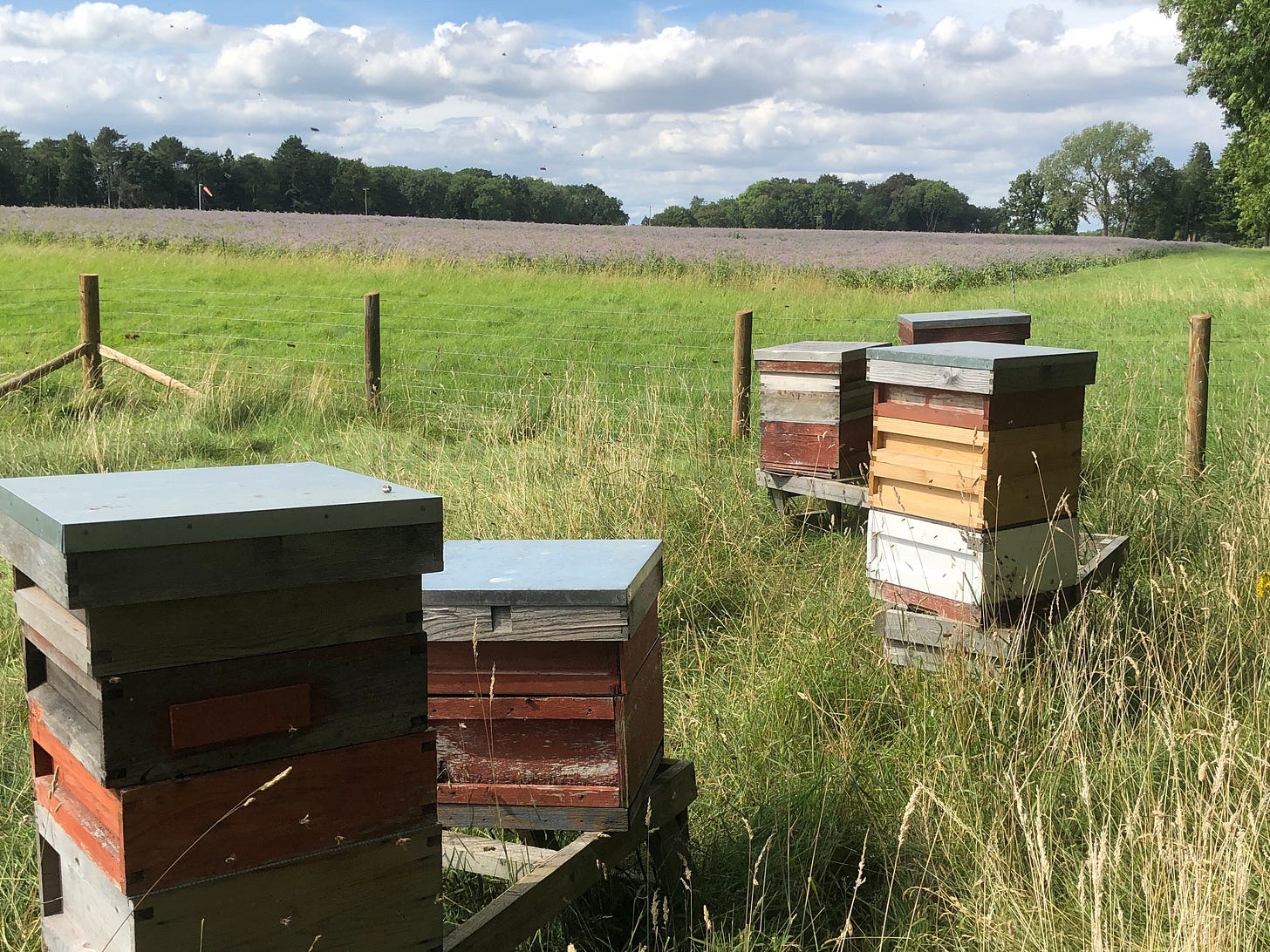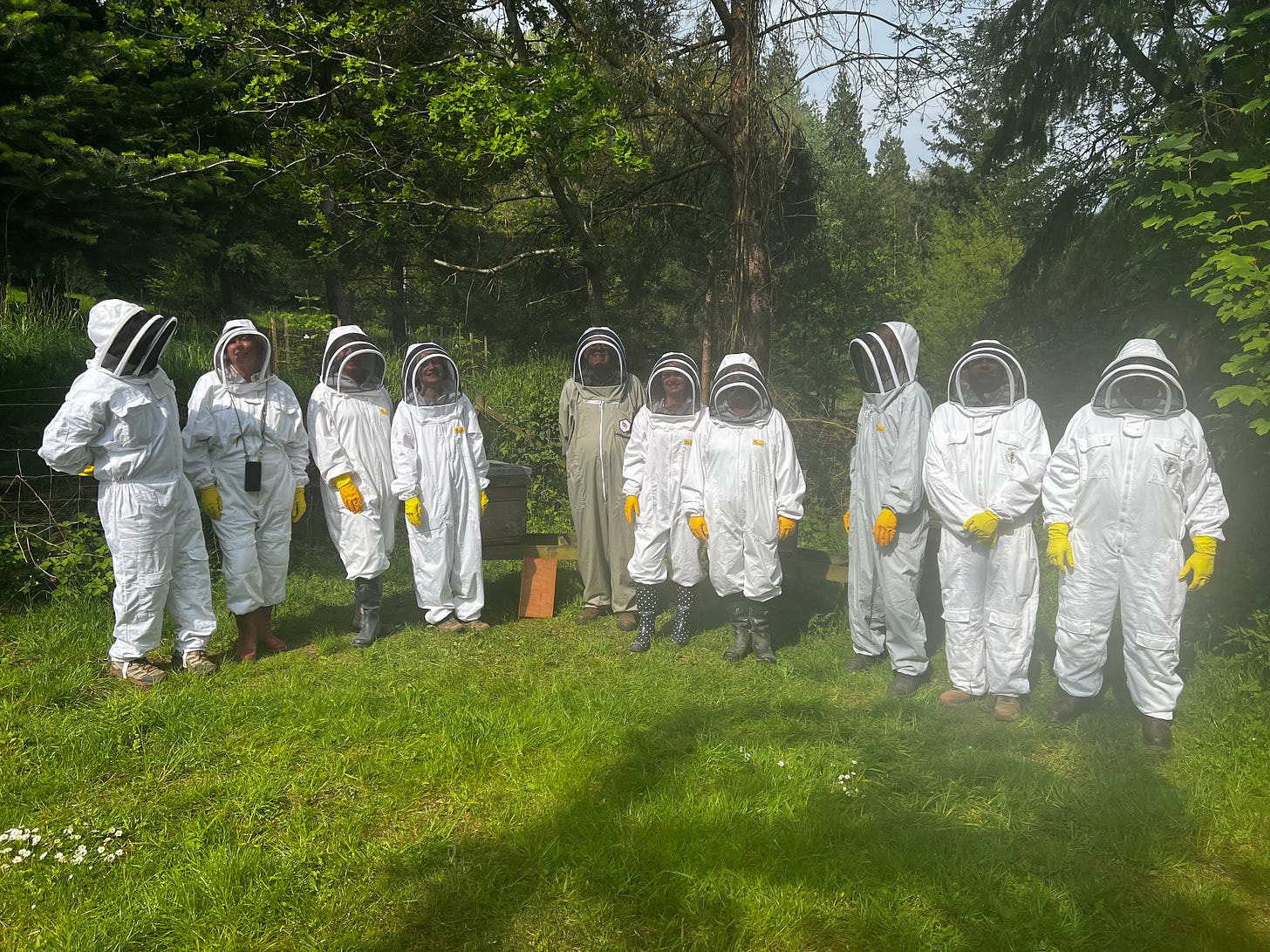Why Swarm Management Is A Vital Beekeeping Skill
It can be controversial, and the Natural Beekeeping Movement would disagree, but swarm management is good for the bees, good for the environment and good for the beekeeper. Here's why.
It’s true that very often swarming is a sign of health in a colony and it is also true that we don’t want to stress our bees by stopping them doing something that they want to do naturally, and that’s why we want to manage swarms and swarming. It’s not a question of control or even stopping them swarming, it’s a question of managing them to ensure the many problems a swarm can create are avoided. Using Padgen or Demaree methods we can allow the colony to think it has swarmed without the trauma of it actually happening. If you want more details then please see our other newsletters or have a look at our YouTube video SWARM MANAGEMENT
This newsletter is not about how to manage swarms but answers the question “why manage them?”
It’s Good For the Bees
It’s a sad fact, but one we need to acknowledge, that many swarms end up going where they are not wanted. They end up in the roofs or walls of houses or outbuildings and are quietly destroyed when nobody is looking. I’ve lost count of the number of swarms I have been called to where I have been unable to collect them but have told the property owner to leave them alone as they will do no harm, only to go past a few days later and see no bees flying. Destruction is the end result of a high proportion of swarms in todays environment. We might not like it, but it’s true. Good swarm management avoids this trauma for the bees.
If left to itself the swarm is very vulnerable. A delay in finding a new home or a few bad days weather when they cannot forage can result in starvation.
The colony that is left behind is also very vulnerable. The new queen only has a couple of weeks to mate and if she is prevented by bad weather or gets killed on one of her mating flights then it is a certain death for the colony unless the beekeeper intervenes. Managing swarms using the Padgen method means that the old queen is still around as an insurance policy.
Artificial swarming prevents swarms really late in the year when it is unlikely the swarm and the colony will survive. Increasingly, we are seeing colonies that are left to swarm naturally doing so late in the year and then both the swarm and the colony starving as there is insufficient time for them to build up before winter. This cannot be good for the bees.
Artificial swarming prevents all of the above and ensure a healthy colony.
It’s Good For The Beekeeper
Allowing a colony to swarm naturally results in a significant loss of honey production, usually at the time when nectar flows are at their maximum. In some cases this will result in little or nothing for the beekeeper and, more importantly, little or nothing for the bees.
Artificial swarming allows an old queen to be replaced simply and easily and reduces the dangers of allowing the colony to supersede often resulting in a poor or aggressive queen.
It’s a great way of increasing your number of colonies without having to pay for more nucs.
It’s Good For The Environment
Swarms can cause havoc and put beekeeping itself at risk - see the last newsletter for details. The swarm can also cause chaos if the environment it chooses is a high street where shops have to be closed or an airport or hospital. So many people are completely divorced from nature that the sight of a swarm in the environment causes panic and demands for immediate destruction.
Artificial swarming ensures that more colonies survive and there are more pollinators in the environment.
Artificial swarming enables the beekeeper to ensure that only queens with a good temperament survive thus reducing the number of people getting stung by aggressive bees and calling for colonies to be moved or destroyed.
NEWS FROM THE APIARY
The early sown borage is now coming through and into flower and the bees are really enjoying it. Much of the borage seed that we wanted to sow at the end of June is still in the shed due to the dry weather. Fingers crossed for some rain but the forecast is not good. Hopefully we will be able to plant it before the season runs out but nothing will germinate in this heat.
Early artificial swarms have reduced the number of colonies trying to abscond but the new ones are now getting to the size where they will be thinking about it. Over the next few days we will be carrying out the Demaree method of swarm management on at least another ten hives.
The amount of nectar coming in has been fantastic but we are now in that period where there is a lot less in flower and also very little moisture in the ground. Hopefully supplies will still be available out there, otherwise they will be eating some of the honey they have already made.
We have also harvested our first honey for 2025 and it is mostly Hawthorn. We have been able to use it for comb honey as the quality is excellent and it is flying out of the door. We are also spinning some for one specific customer. If you want to buy some please click here Comb Honey
It’s all go
Course News
For those of you who are interested in beekeeping or want to top up your knowledge then please give our online courses a try ONLINE COURSES and if you are one of our paid newsletter subscribers please remember to claim your discount.
We don’t have too many courses left in the diary and only a few places left, so if you fancy getting ready to start beekeeping next year please book on one of the later courses now. We are also open for booking for 2026. We don’t have dates yet but anyone booking now will get the advantage of the 2025 prices.
Both the one day and two day courses this weekend are fully booked, we have three places left on the one day course on 26th July and the same on the 9th August. Our last course for this year is on 16th August and we only have a couple of places left on that one.
If you would like to take up one of those places please contact Denise on denise@cotswoldbees.co.uk
The weather has been great for holding courses and we are now well into the 2025 programme. People from all areas of the country and from all walks of life have been descending upon Batsford to learn about beekeeping and eat Carol’s flapjacks.
If you are comparing prices please keep in mind that our courses include the use of a bee suit. We are starting to see some cheaper courses appear on the market where you need to bring your own suit. We also include lunch, Carol’s famous flapjacks, biscuits and tea and coffee.
Jobs To Do In The Apiary
Inspect regularly
Carry out varroa checks
Be ready to carry out swarm management before it is too late.
Put on new supers as the existing ones fill up.
Make sure bees have plenty of water available close to the hive.
Be on the lookout for disease, particularly American and European Foul Brood, both of which much be notified to the bee inspector.
Begin sorting out any colonies you want to split or re-queen.
Order new queens if you are not raising your own.
Order varroa treatments ready for the end of the season
YouTube
Please pop over to YOUTUBE for a look and if you enjoy those videos please feel free to suggest any that you would like us to make. We now have just over 10,000 subscribers to our YouTube Channel. If you enjoy the videos but haven’t subscribed yet please do so as it really helps us get our videos noticed.
We now have a new video showing us harvesting some comb honey IS THERE HONEY FOR TEA? Next week will begin a new series of YouTube shorts about honey bees and flowers. Please keep an eye open for that.
We have also signed up to the “Buy Me A Coffee” scheme and so if you want to buy me a coffee to go with the inevitable cake after you have watched the video then thank you in advance. This goes some way to helping with the cost of making the videos.
Bee Buzziness
The Latest Buzz From The Bee World
A recent article by Chris Weber outlines the details of the recent discovery in the Jordan Valley of a beehive dated to around 10,000 years ago. We have always thought that beekeeping began around 4,000 years ago but this latest find puts that into question.
The hive was actually discovered in 2018 and was beautifully protected due to the environment. There were not only parts of the clay pot but also comb, wax and even bits of very old bees. The hive was made of a mixture of clay and straw. It would also appear that the ancient beekeepers used specialist tools to harvest their honey as there are still tool marks on the hive caps. Amazingly, it would also appear that our ancient colleagues even used a special resin to seal the area damaged during harvest.
I’m off to update my slides that I use on our introduction course.
Finally, A Request From Us Please
These newsletters are sent to all subscribers free of charge, but if you would like to support us and make a contribution toward the costs of producing them please sign up for a monthly or annual paid subscription. It costs less than a couple of coffees per month and you can unsubscribe at any time. Paid subscribers also get discounts on the price of online courses and some specials. Thank You








